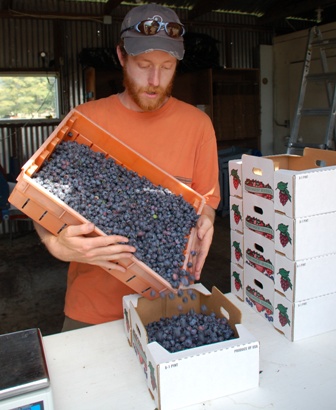Resources to Contact Local Growers
-
 State agricultural extension offices
State agricultural extension offices
-
Local business and organizations that work with the agricultural community
-
Food co-ops
-
State agricultural insurance companies
-
Food banks
It is important to first contact these established groups with information about your program, and then ask them to either pass-on information directly to growers in your area or indirectly by referring the growers to you.
Community Action previously had a program established called the Skagit Food Share Alliance. This program raised funds from the community, and then used those donations to purchase fresh produce from local growers. Due to this program, there was already a relationship established with the local growing community. Thus, the majority of growers contacted were already with Community Action.
Talking to your local food banks is also a great way to find growers who are potentially open to gleaning. Many growers already directly donate to food banks, and therefore are open to the idea of giving produce to the emergency food system. These growers should be contacted as gleaning might make donating food easier for them.
Methods for Contacting Donors
Phone
Cold calls are not highly recommended, as they often get a negative reaction from growers, and may make them less likely to participate in the future. It is ideal to call growers only when you have a direct referral. It is also best in this situation if the person who is referring you can be on the call with you and introduce you to the grower.
Email/ Letter
For those growers who are cold contacts, a non-direct primary form of contact is ideal. This can include sending them a letter or an email. After enough time has passed you may then call the grower on the phone.
Flyers
To “recruit” growers who you do not have contact information, flyers are a great form of advertisement. Best are flyers that have pull away tabs with contact information at the bottom. These should be put in places where growers are likely to visit, such as extension offices and agricultural supply stores. See an example here.
In Person
It is ideal no matter how you initially contact growers to visit their actual property. This is best done in the off-season when growers are less busy. This gives you the opportunity to become familiar with their location, which is helpful when giving directions to volunteers when you return to glean. It also helps build trust because growers get to see you, and know that you value your relationship as you are putting time into visiting them.
Also, use this as an opportunity to see their farm and ask questions about gleaning, like where should volunteers park? Are there bathrooms accessible for volunteers? Meeting growers in person also gives you an opportunity to be introduced to other growers. Let the farmer know you are looking for more people who are interested in participating. Ask them if they know anyone who might be interested, as they will likely know other growers in the area. Then, when contacting that grower, let them know who referred you.
What to Bring When Contacting Growers
Visiting a grower is an opportunity to exchange materials. Make a folder for the grower, which should include, but is not limited to:
By having all this information with you it shows you are organized, have thought out gleaning, and thus will be successful. Also, the language you use to construct your relationship with the grower is very important. When talking to the grower you do not want to approach them with the expectation they will definitely donate food. Instead, you want to address the program as a benefit to them, by making donating food as easy as possible for them. Let them know they do not have to make any promises, but you are just available to them if they happen to have some food to donate. Then, after having worked with the grower for at least a year, you may want to re-approach them and ask them for a pledge. However, this is not necessarily something all growers will be open to, so make sure to get to know the grower and assess whether this is something they might do.

 State agricultural extension offices
State agricultural extension offices